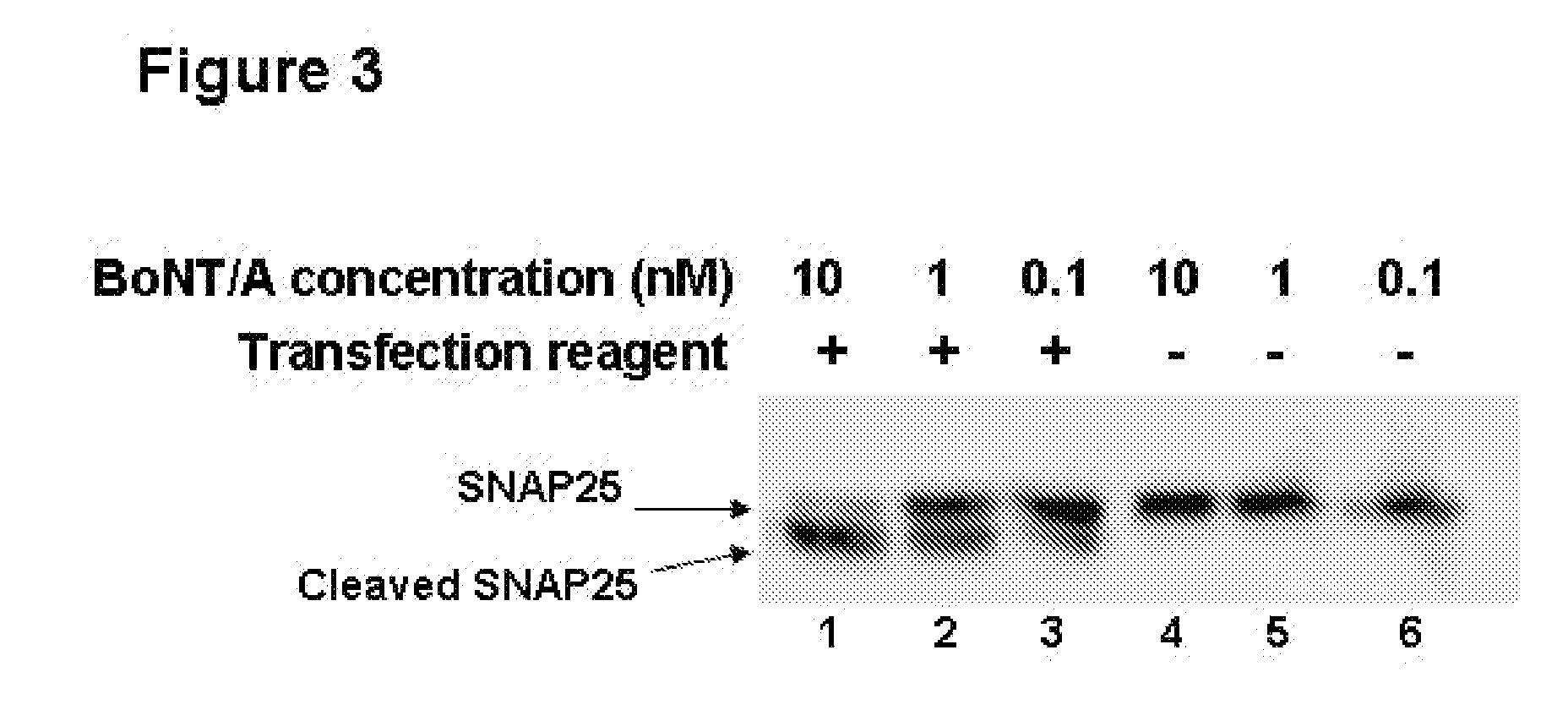Methods For The Delivery Of Toxins Or Enzymatically Active Portions Thereof
a technology of enzymatic active parts and toxins, applied in the field of cell-based assays for toxins, can solve the problems of inability to detect toxins, and inability to obtain primary cultures, etc., to achieve the effect of broadening the range of toxins, increasing the number of cell lines available, and increasing the sensitivity of these cell lines
- Summary
- Abstract
- Description
- Claims
- Application Information
AI Technical Summary
Benefits of technology
Problems solved by technology
Method used
Image
Examples
example 1
Summary
[0098]The present invention improves the utility of cell-based toxin assays through the use of a novel toxin delivery system that easily and dramatically increases the functional entry of botulinum neurotoxin (BoNT), and probably other related toxins, into cells. It was discovered that the functional delivery of botulinum neurotoxin (BoNT), serotype A, to cultured neuronal cells can be substantially improved by combining it with DNA transfection reagents before application. Surprisingly, this toxin “transduction” approach is also successful for the delivery of BoNT to all non-neuronal cells tested, cells which normally are completely refractory to intoxication. Finally, intoxication efficiencies were achieved approaching those of holotoxin in these cell lines by transducing only the BoNT catalytic domain into the cells using the DNA transfection reagents, obviating the need to use holotoxin to intoxicate cultured cells and avoiding the consequent safety and regulatory issues....
example 2
Methods
Materials and Methods.
[0099]Cell culture and reagents:
[0100]M17 (ATCC #CRL-2267) cells were maintained in DMEM (Gibco, USA) containing 10% fetal bovine serum (FBS) (Gibco, USA). MEME (Gibco, USA) plus 10% FBS media were used for culturing Neuro2a (ATCC #CCL-131) and HEK293 (ATCC #CRL-1573) cells. HIT-T15 (ATCC #CRL-1777) cells were cultured in F12K (Gibco, USA) containing 10% horse and 5% FBS. 6×104 cells were seeded onto each well of 24-well plate and maintained at 37° C. After 72 hrs, culture medium was replaced with fresh medium before experimental treatments. Primary cultures of cerebellar granule cells were prepared from 7 day-old Sprague-Dawley rats essentially by the methods of Farkas. Briefly, after aseptically removing cerebella from the skulls, tissue was freed from meninges and incubated in 0.05% trypsin solution for 10 min at RT. After a brief centrifugation, cells were triturated in DMEM / F12 containing 10% FBS and filtered through a sterile cell strainer mesh wit...
example 3
Results
[0112]Commercial Lipid-Based DNA Transfection Reagents Enhance botulinum Intoxication of Cultured Neuronal Cells.
[0113]It was observed that neuronal cells intoxicated with BoNT / A immediately after DNA transfection using the FuGene-HD reagent (Roche) appeared more efficiently intoxicated than control cells so the effect of FuGene-HD on BoNT intoxication was directly tested. The measure of BoNT serotype A intoxication used in these studies was the percentage of the cellular SNAP25 that had been cleaved. As shown in FIG. 1, virtually no SNAP25 was cleaved following 3 hrs intoxication and about 50% was cleaved with 24 hrs exposure to BoNT / A in M17. When the toxin was pre-incubated with FuGene-HD prior to addition to media, approximately 50% of SNAP25 became cleaved with 3 hrs of toxin exposure and 90% was cleaved in M17 after a 24 hrs exposure. The effect of the FuGene-HD DNA transfection reagent on intoxication efficiency was even more profound in the Neuro2a neuroblastoma cell...
PUM
| Property | Measurement | Unit |
|---|---|---|
| Fraction | aaaaa | aaaaa |
| Time | aaaaa | aaaaa |
| Time | aaaaa | aaaaa |
Abstract
Description
Claims
Application Information
 Login to View More
Login to View More - R&D
- Intellectual Property
- Life Sciences
- Materials
- Tech Scout
- Unparalleled Data Quality
- Higher Quality Content
- 60% Fewer Hallucinations
Browse by: Latest US Patents, China's latest patents, Technical Efficacy Thesaurus, Application Domain, Technology Topic, Popular Technical Reports.
© 2025 PatSnap. All rights reserved.Legal|Privacy policy|Modern Slavery Act Transparency Statement|Sitemap|About US| Contact US: help@patsnap.com



